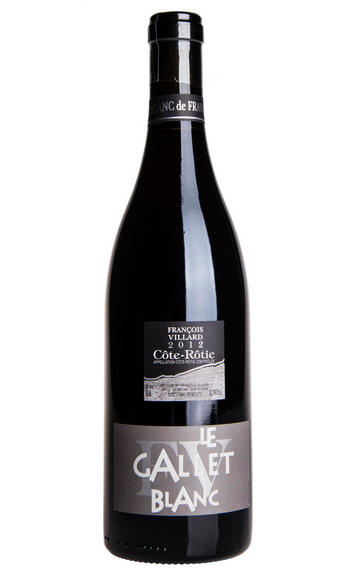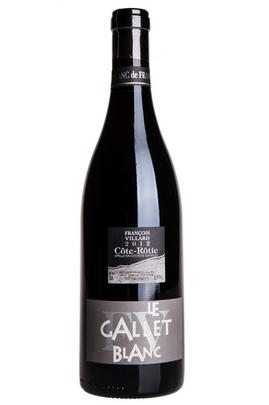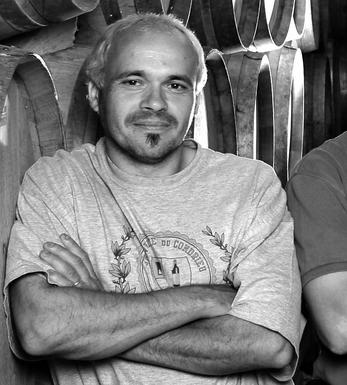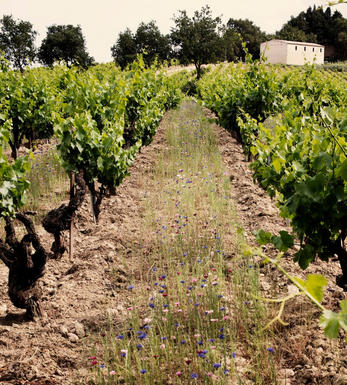
2012 Côte-Rôtie, Gallet Blanc, François Villard, Rhône

Critics reviews
Jeb Dunnuck - Wine Advocate #210, Dec 2013
Jancis Robinson MW, jancisrobsinson.com - Jan 2014
About this WINE

Domaine Francois Villard
François Villard has grown his tiny wine domaine from four to seven hectares and still produces a miniscule amount of highly allocated bottlings. Referred to by Robert Parker as one of the “stars” of the Northern Rhone, François also acquired a small parcel in Cote-Rotie and a few hectares in St. Joseph. Formerly a chef, François brings his complex palette to the winery to produce wines of power and grace that age for years.
The terroir of the Northern Rhone is, in a word, amazing. Fully exposed hillsides that face the East are covered with terraces first created by the Romans. The soil is made up of small gravel and decomposed schist over a bedrock of granite. The exposition allows for excellent ripening of the Viognier and Syrah grown on these coteaux and for exceptional water drainage (So much so that terraces are always needing to be re- paired.) The climate is warm with much cooler night than those found in the South.
François Villard’s strategy is to allow for the most optimal ripening possible. His wines, as a result, are rich and concentrated with complex aromas of peaches, apricots, honeysuckle, and honey for the whites and leather and spice for the reds. The whites are often allowed to develop botrytis and most of the wines pass through wood ageing for an extended amount of time to prepare them for a very long life in bottle.
The absurdly steep hillsides of the Northern Rhone mean that harvesting by hand is the only option open to winemakers. François Villard and his crew harvest in very small baskets along extremely narrow terraces, making for backbreaking and danger- ous work. These baskets are then emptied into larger boxes to be taken down the hill- sides by tractors, and in some cases, donkeys. The results, however, are unrivaled

Côte-Rôtie
Côte-Rôtie is one of the most famous of the northern Rhône appellations, with some single vineyard cuvées now selling for the same prices as First Growth Bordeaux. It is the northernmost outpost of the Syrah grape.
Côte-Rôtie translates as ‘roasted hillside’, as the south-facing slopes are exposed to the maximum-possible sunlight. Vines have been planted here since Roman times, although the appellation was only created in 1940. Today it covers 500 hectares, with 276 hectares of vineyards stretched across eight kilometres.
Phylloxera devastated vineyards in the late 1800s and Côte-Rôtie’s fortunes remained in the doldrums for another century. After the War, a farmer would receive double the price for a kilo of apricots as for a kilo of grapes, hence vineyards were grubbed up and wine production became increasingly smaller.
It has only really been recognised as a top-quality wine-producing area since the 1970s, with Guigal being the main impetus behind its revival. The two best slopes, Côte Brune and Côte Blonde, rise steeply behind Ampuis and overlook the river. The Côte Brune wines are much firmer and more masculine (the soils are clay and ironstone), whereas the Côte Blonde makes wines with more finesse and elegance due to its light, sandy-limestone soil. Both the Côte Brune and Côte Blonde vineyards rise to 1,000 feet, with a gradient of 30 to 50 degrees.
The wines are made from the Syrah grape, however up to 20 percent of Viogner can be used in the blend, adding finesse, elegance and floral characteristics to the wine. Viognier ripens more quickly than Syrah and the appellation rules stipulate that the grapes must be added to the fermentation – rather than blended later. The best Côte-Rôtie are very deep in colour, tannic and spicy, and need 10 years to evolve and develop.
There are nearly 60 official vineyards (lieux-dits); the best-known are: La Mouline, La Chatillonne (Vidal-Fleury, owned by Guigal) and La Garde (Rostaing) in Côte Blonde; La Viallière, (Rostaing), La Landonne (Guigal, Rostaing) and La Turque (Guigal) in Côte Brune.
Styles vary from heavily-extracted tannic wines which need many years to soften through to lighter, supple and less-structured wines which do not require extended bottle ageing. The most famous wines of Côte-Rôtie are Guigal’s three single-vineyard cuvées: La Mouline, La Turque and La Landonne. These are aged in new wood for 48 months, and demand for them amongst connoisseurs and collectors is significant, leading to prices sometimes comparable to Bordeaux First Growths.
Recommended producers: Guigal, Gerrin, Rostaing, Ogier, Burgaud
Best vintages: 2006, 2005, 2004, 2001, 1999, 1991, 1990, 1985

Syrah/Shiraz
A noble black grape variety grown particularly in the Northern Rhône where it produces the great red wines of Hermitage, Cote Rôtie and Cornas, and in Australia where it produces wines of startling depth and intensity. Reasonably low yields are a crucial factor for quality as is picking at optimum ripeness. Its heartland, Hermitage and Côte Rôtie, consists of 270 hectares of steeply terraced vineyards producing wines that brim with pepper, spices, tar and black treacle when young. After 5-10 years they become smooth and velvety with pronounced fruit characteristics of damsons, raspberries, blackcurrants and loganberries.
It is now grown extensively in the Southern Rhône where it is blended with Grenache and Mourvèdre to produce the great red wines of Châteauneuf du Pape and Gigondas amongst others. Its spiritual home in Australia is the Barossa Valley, where there are plantings dating as far back as 1860. Australian Shiraz tends to be sweeter than its Northern Rhône counterpart and the best examples are redolent of new leather, dark chocolate, liquorice, and prunes and display a blackcurrant lusciousness.
South African producers such as Eben Sadie are now producing world- class Shiraz wines that represent astonishing value for money.


Buying options
Add to wishlist
Description
François describes this wine as his Burgundy. His philosophy of generous cuvaison but no pigeage has as its goal a silky and elegant mouth feel, in itself not undermined by the 50% of stems that have not been discarded. The stems indeed are seen as providing a sense of terroir, in this case the terroir of seven individual plots, most of which are at the southern end of the appellation.
Simon Field MW, Rhône Wine Buyer
The loquacious François Villard is something of an instinctive winemaker. Sometimes his instincts take him down a cul-de-sac, but generally they demonstrate a clos affinity to his many and varied plots and projects. It is therefore not entirely inappropriate that he cites 2012 as a vintage of great purity and potential, but also one where there is a greater qualitative gap than sometimes between good and less good examples. We, unsurprisingly, have decided to buy the wines which fall into the former group.
wine at a glance
Delivery and quality guarantee